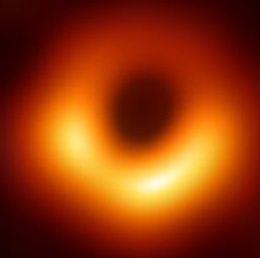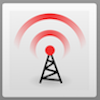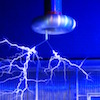Friday Flyer - April 12, 2019

Spotlight on Black Holes, because we can
If you spent the past few days in the CMS cavern disassembling HCal, you might not have seen the image that, for now, graces our "Spotlight" section. Now you can join the excitement with the rest of us. The Event Horizon Telescope project unveiled the first-ever image of a black hole. This was no little Cygnus X-1 but the supermassive object at the core of the M-87 galaxy. The image shows luminous accreting matter around an empty space about 2.5 times the size of the event horizon. It was taken with a series of millimeter wavelength telescopes spread around the world, using the rotation of the earth to make a composite world-sized telescope. You may want to take a look at the NSF announcement press conference (starts 33 minutes into the video) and read up on it in Astronomy. Or you can go to the actual paper in Astrophysical Journal Letters.
If you are looking for a QuarkNet connection, we have it. Boston center fellow Mike Wadness writes of his former student, Joe Farah: "Joe is currently a sophomore astrophysics major at UMass Boston and a Harvard-Smithsonian research fellow. Before starting his freshman year in college, Joe networked and knocked on doors until he found himself writing code and building new muon detectors for the ATLAS upgrade. He then continued his networking and eventually landed a position with the Event Horizon Telescope at Harvard-Smithsonian. Every time he knocked on a door, he used his high school QuarkNet experiences of studying cosmic rays and masterclass as part of his resume. Joe's contribution has been so significant that he holds the distinction of being the first and only undergraduate to be granted official collaborator status and has authorship on all six of the EHT publications. Although there are numerous other influences that have brought Joe to this position at such a young age, he includes QuarkNet as one of the more significant factors."
Want more? Perimeter Institute has a guide to understanding the image, a set of posters, and a classroom activity.

News from QuarkNet Central
April is a good time to plan summer activities your center may have. If you can pick dates, please send them to Ken or Shane. And if you are interested in having a workshop from QuarkNet roll into town, take a look at the possibilities on the National Workshop page.
A reminder for teachers: We have been recruiting for QuarkNet Data Camp, to be held at Fermilab, July 14–19. Data Camp is the national flagship workshop for QuarkNet, and if you have not gone yet, you should throw your hat in the ring. Data Camp participants are nominated by mentors (1–2 per center), so, if you are interested, let your mentor know. Learn more from the Data Camp flyer.

Physics Experiment Roundup
LHCb leads the list with a new pentaquark discovery explained on the collaboration website. CMS explains their search for four-top events. And we have two articles from symmetry. The first, about searching for WIMPs in a dark matter wind, seems like some difficult physics. The second, seemingly out of the "What can go wrong?" department, is about experiments designed by theorists. To be fair, the article explains why they are doing it and how it can go right.

Resources
Timing! We have a nice article in symmetry on facts about gravity—a nice counterpoint to our black hole theme—and, as they say about Fg, it was worth the weight. For more "out there" physics, symmetry comes right back with a video on parallel universes. The New York Times contributes a way-cool video on a more seemingly ordinary sort of physics.

Just for Fun
Does xkcd have a take on the black hole image and EHT? Of course it does, here (sarcastic humor) and here (actually pretty useful). And we leave it to BBC to leave you with some black hole memes.
QuarkNet Staff:
Mark Adams: adams@fnal.gov
Ken Cecire: kcecire@nd.edu
Shane Wood: swood5@nd.edu
